TL;DR: On Tuesday, October 25 2016, a small JavaScript framework, Next.js was released to the public. It's a minimal framework for building server-rendered universal JavaScript web apps. Within a few months of its existence, it gathered a lot of attention from the JavaScript community. The React community was set ablaze with joy for finally having a tool that can help build server-side rendering apps without hassle and in-depth technical know-how. In fact, we covered how to build a universal JavaScript web app with it. The team behind Next.js did not take a break, they continued working tirelessly for months to fix several bugs, improve performance and still make the framework as simple as possible. Their efforts have yielded a Next.js 2.0 release.
What is a Universal JavaScript Application?
Just to provide a little context for the individuals that find Universal JavaScript to be a new term.
The term Universal simply means the ability to run the same code on the server, browsers, mobile devices and any other platform. Universal Javascript is a term people are leaning towards these days. A lot of developers also call it Isomorphic JavaScript. In short, there is a debate on the React repo about this term. Michael Jackson, a popular ReactJS developer wrote a blog post on Universal JavaScript. It's indeed true that naming things is one of the most difficult aspects of Computer Science.
What's new in Next.js 2.0 ?
Next.js 2.0 was released on On March 27, 2017. It comes bundled with a set of new features and improvements of existing features. Next.js 1.0 already included the following features:
- Hot code reloading
- Automatic transpilation and bundling(using babel & webpack)
- Server rendering and indexing of JavaScript files in the
/pagesdirectory - Serving of static files
- CSS isolation and modularization
So, what has changed? What improvements have been made? Are there new features? Will your Next.js apps built with this new release be truly production ready? Let's go through everything that Next.js 2.0 has to offer.
1. Faster Compilation Times
Every developer and their dog need their apps to be highly performant from development stage up until production. A lot of work has been done to improve the dev build time that Next.js 1.0 brought to the scene. With great joy, I hereby announce to you that Next.js 2.0 comes bundled with shorter build/rebuild times. This was made possible by offering Lazy compilation during development. This simply means that before now, when you run next, it compiles all the pages. But now, lazy compilation ensures that it is only when a user hits a page, that compilation happens. So each page that is called by the user is an on-demand entry.
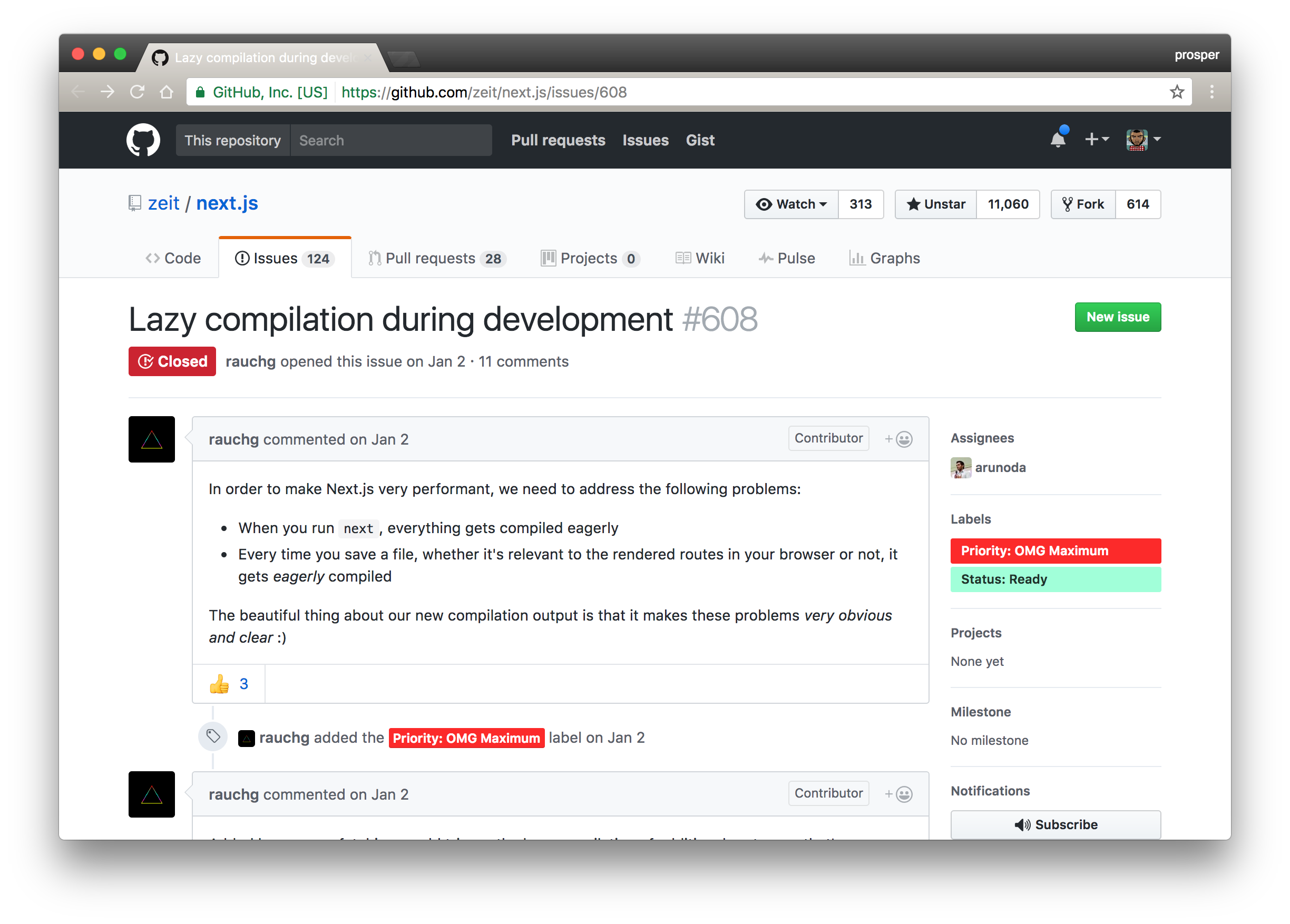
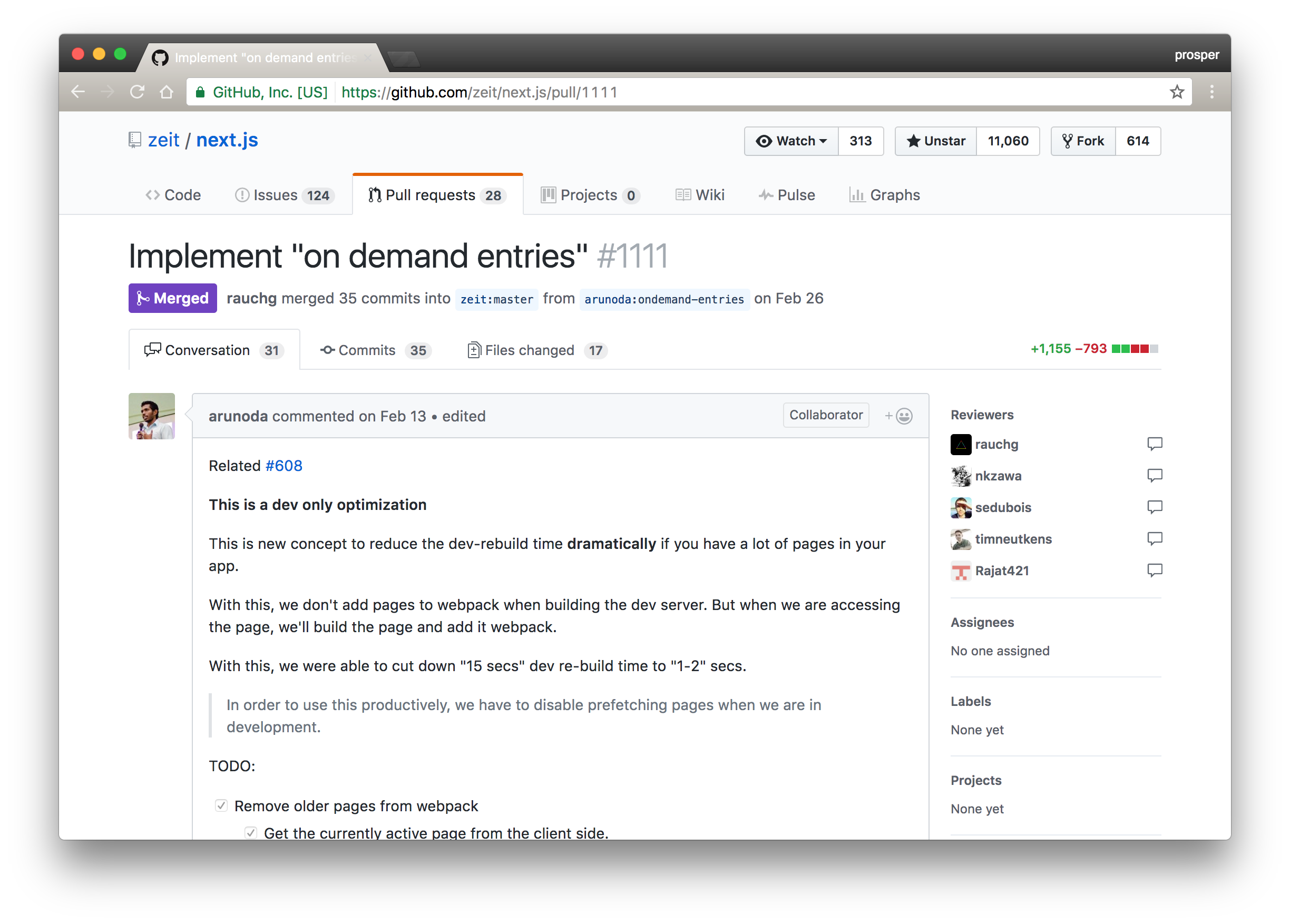
2. Ahead-of-Time Gzip Compression
Next.js 2.0 automatically gzips all your static JavaScript files and serves them when you build your app by running next build . This saves a lot of CPU power especially for apps deployed in cloud function-like environments.
3. Smaller and Efficient Builds
Apart from reducing the dev build times, Next.js 2.0 offers much smaller and more-efficient builds than its' previous version. So by default, your app size is now smaller.

Source: zeit.co
Page loads have also been made faster by making initial bundle files to be cached permanently on clients.
An issue was raised in Next.js 1.0 about shared dependencies between pages that caused latency when browsing through different server-rendered pages, and the ever-ready team found a way to solve it by setting up Webpack common chunks to avoid shipping repeated code across components.
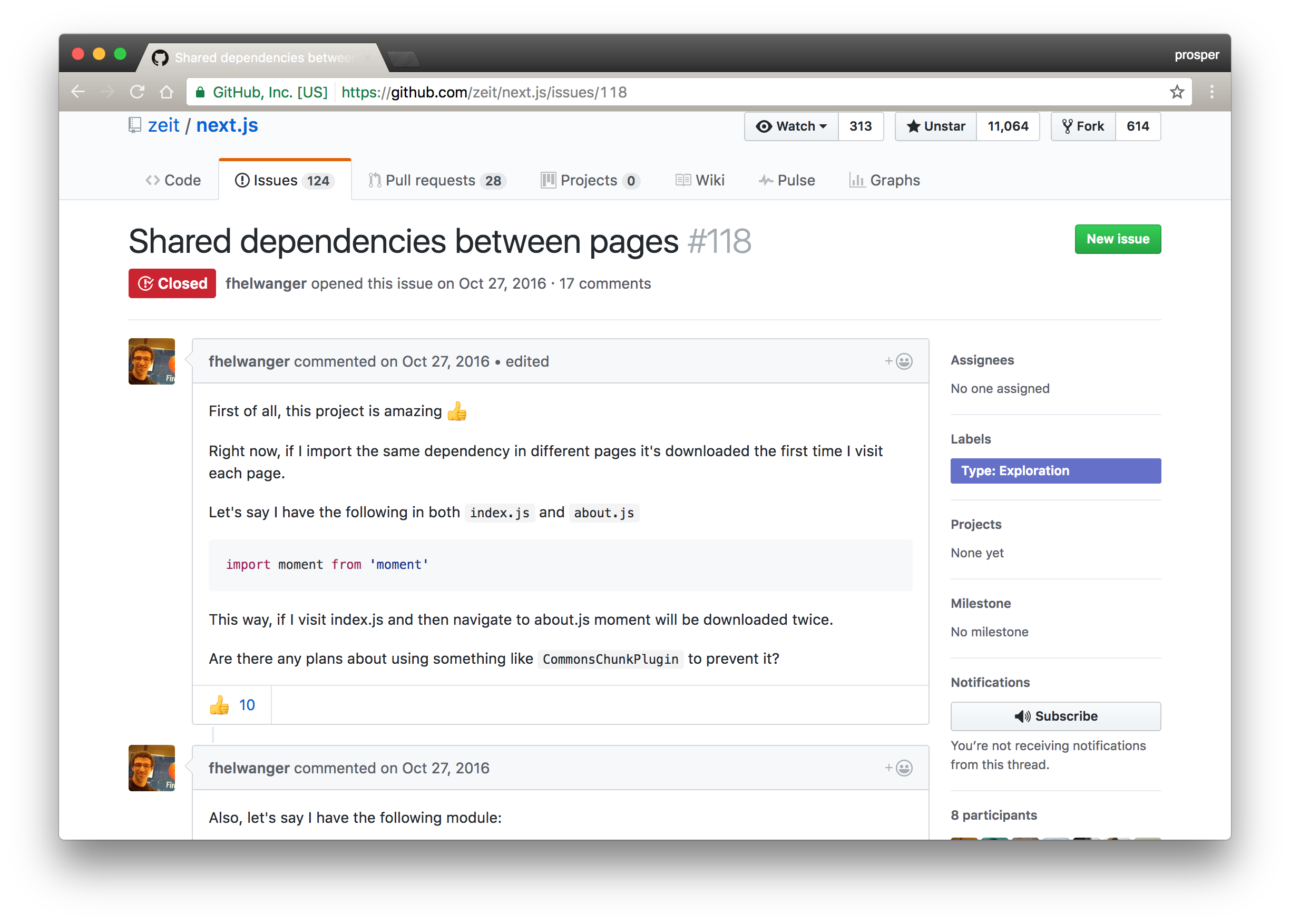
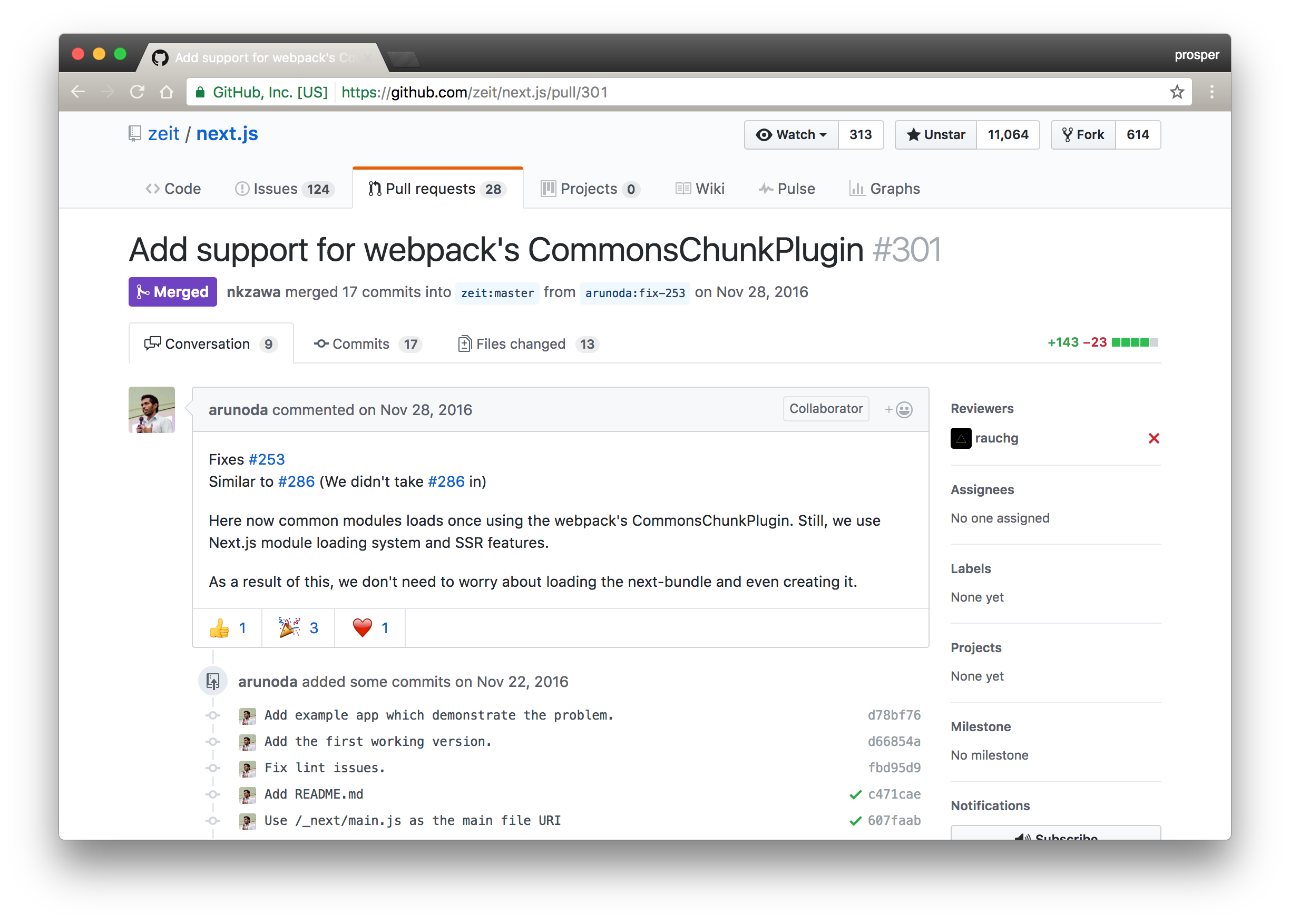
4. Programmatic API for Routing
In the first major version of Next.js, dynamic routing was only possible with query strings. There was no way to acheive clean and fancy URLs and loading your own custom server code was a big challenge. With Next.js 2, those challenges are a thing of the past.
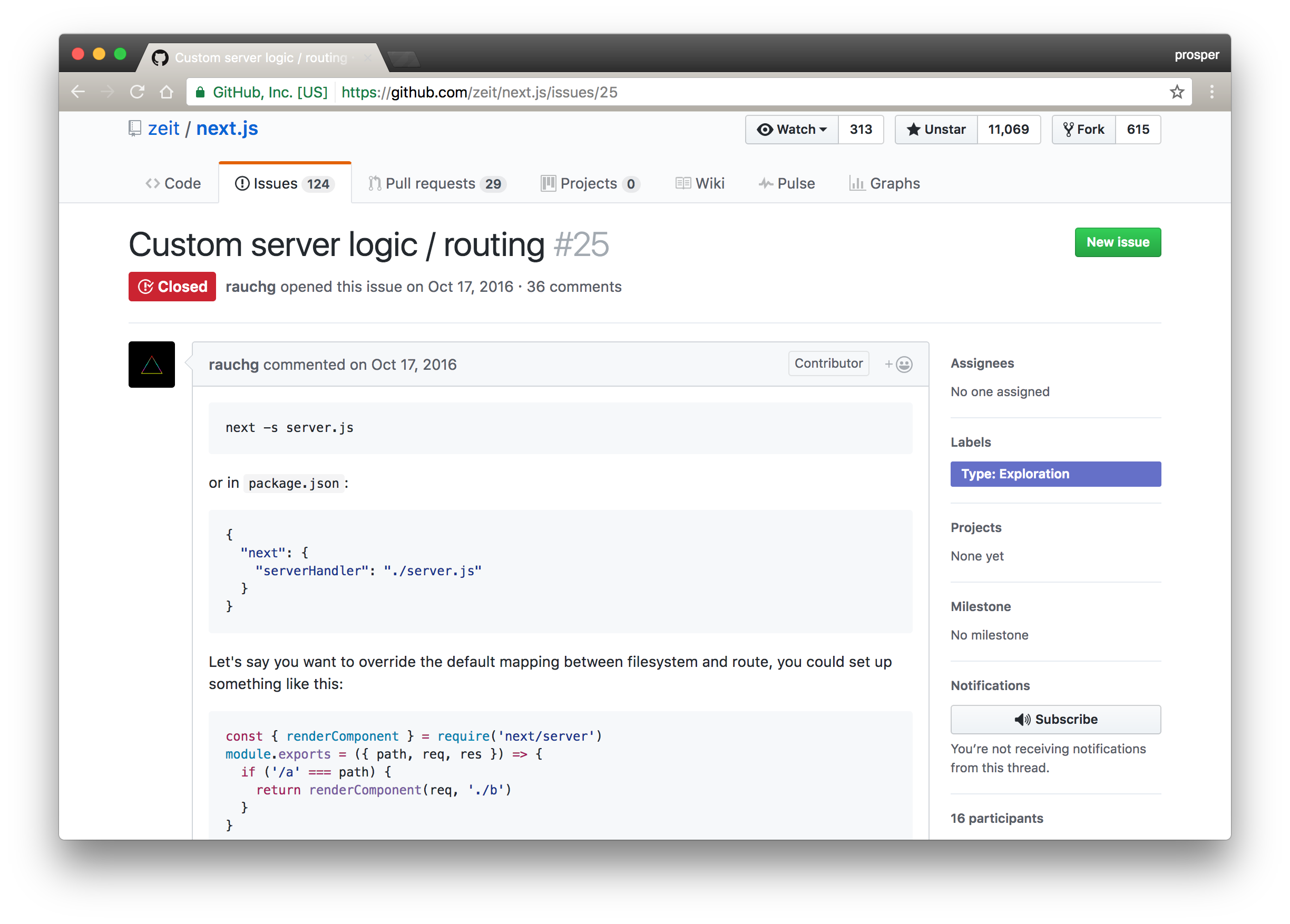
You can now write your own custom server programmatically, customize routes and use different route patterns like so:
const express = require('express')
const next = require('next')
const dev = process.env.NODE_ENV !== 'production'
const app = next({ dev })
const handle = app.getRequestHandler()
app.prepare().then(() => {
const server = express()
server.get('/p/:username', (req, res) => {
return app.render(req, res, '/z', {
...req.query,
username: req.params.username
})
})
server.get('*', handle)
server.listen(3333)
})In the code sample above, you have set up a custom server. The path /p/prosper where prosper is the :username is resolved to ./pages/z . The page gets access to the username parameter and can do whatever has been programmed in it. Check out this example.
5. Pre-fetching Pages
Next.js 2 comes bundled with an API that allows you prefetch pages. Any <Link> tag can accept a prefetch prop and prefetch the pages it links to in the background like so:
import Link from 'next/link'
export default () => (
<nav>
<ul>
<li><Link prefetch href='/pricing'><a>About</a></Link></li>
<li><Link prefetch href='/auth0'><a>Contact</a></Link></li>
</ul>
</nav>
)This gives you the performance of an SPA coupled with server rendering. Wow, that's better performance with little efforts. Whoop! Whoop!
6. Immutable Caching
When you build your app with next build and start your app, Next.js 2 will serve your JavaScript files and other assets as immutable assets. This simply means that once the browser has downloaded any immutable asset, if you reload the browser page, your browser won't try to load these assets from the server again.
Another gain for performance and speed. Whoop! Whoop!
7. Custom Babel and Webpack Configurations
Next.js 2 is fully extensible. You have complete control over Babel's and Webpack's configuration. For example, if you want to extend Babel, you can simply define a .babelrc file at your app's root and apply next/babel preset. With that, you include whatever babel plugins you need like so:
{
"presets": ["next/babel"],
"plugins": ["transform-flow-strip-types"]
}Check out this working example.
sample .babelrc file
To extend the usage of Webpack in Next.js, you can create a next.config.js file in the root of your project's directory. Once you have that, you can define a function in the Node.js module like so:
module.exports = {
webpack: (config, { dev }) => {
// Perform customizations to config
// Important: return the modified config
return config
}
}Note: The next.config.js file is a regular Node.js module.
8. Composed CSS support
Before now, next/css was the default CSS-in-JS solution for Next.js. In Next.js 2, it has been deprecated in favor of styled-jsx, a Babel transformation that provides full, scoped and component-friendly CSS support for JSX (rendered on the server or the client).
export default () => (
<div>
<textarea />
<button>add comment</button>
<style jsx>{`
textarea {
width: 400px;
height: 100px;
display: block;
margin-bottom: 10px;
}
button {
padding: 3px 4px;
}
@media (max-width: 750px) {
textarea {
width: 100%;
}
}
`}</style>
</div>
)In the code example above, you can see how it provides scoped support for this JSX-written component.
9. Isolating React From Next
Before now, Next.js shipped with React. All you needed to do was:
npm install next --saveIn Next.js 2.0, you now need to bring in next with react and react-dom like so:
npm install --save next react react-domThis creates opportunity for you to use other React API implementations such as Preact. It also allows you to update React independently of Next.js.
9. Practical Examples of Backend Integrations
Many developers have been helping out in providing examples on how to integrate Next.js with several backend technologies.
10. Availability of Learning Platforms
It's amazing to see that in a short time that Next.js has been in existence, lots of examples have been amassed and there is a learning platform that the Next.js team approves of. With the release of Next.js 2, we have:
- About 48 examples of integrating Next.js with Apollo, Inferno, Preact and ways of achieving different common functionalities with Next.js
- learnnextjs.com, built by Arunoda Susiripala

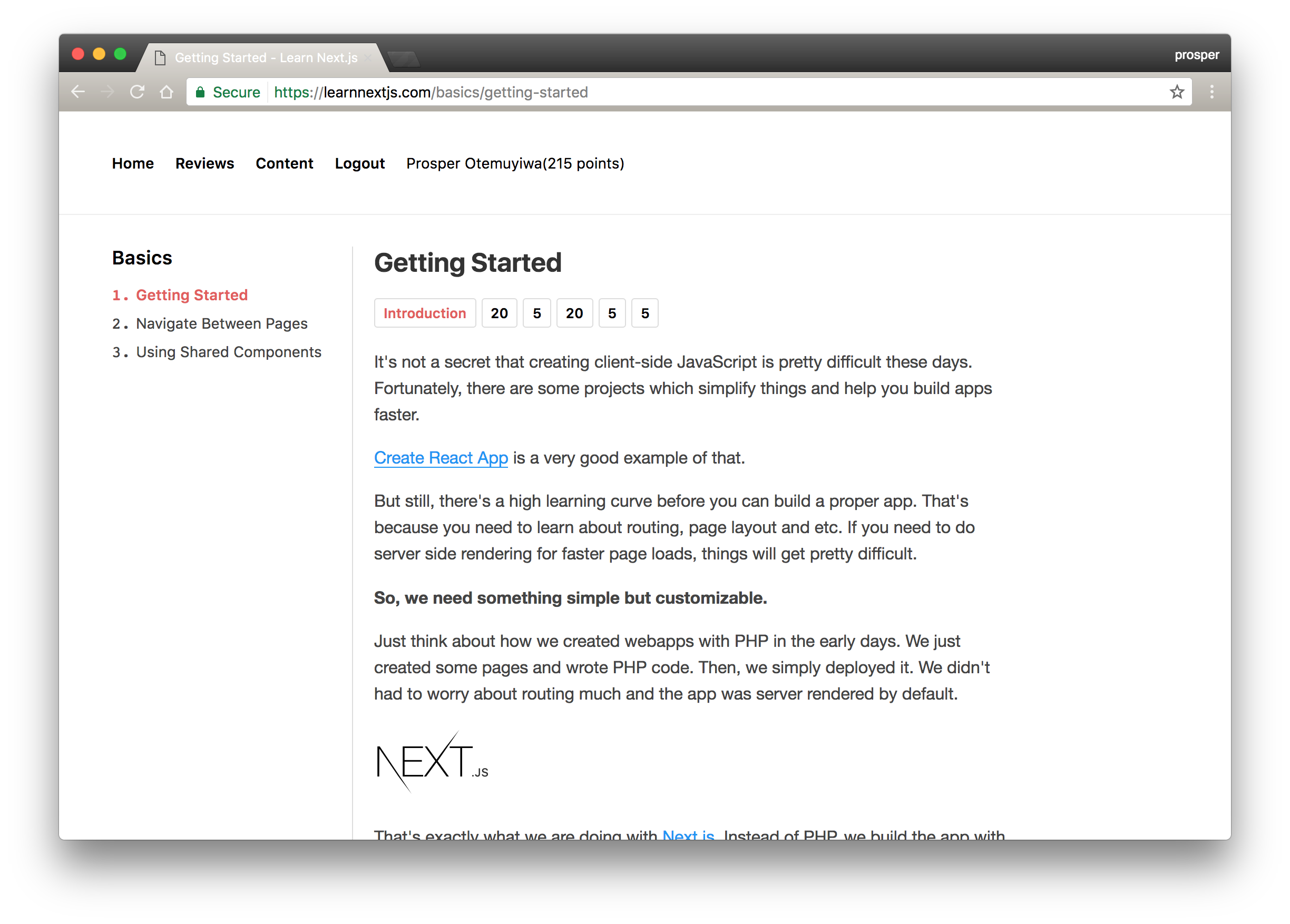
Oh, the UI and Backend for learnnextjs.com is open-source. This presents another opportunity to learn Next.js 2.0 by going through its source code.
Enter Next.js 2.2.0
Next.js 2.2.0 was tagged yesterday. It comes bundled with some nice changes:
- CDN support: You might want to upload all your static files to a CDN, including build files. Now, you can serve Next.js static assets via a CDN. All you need is to expose the following option in
next.config.jslike so:
const isProd = process.NODE_ENV === 'production'
module.exports = {
// You may only need to add assetPrefix in the production.
assetPrefix: isProd? 'https://cdn.mydomain.com' : ''
}More information can be found here.
- ETag support for server rendered pages : The ETag HTTP response header is an identifier for a specific version of a resource found at a URL. It allows caches to be more efficient, and saves bandwidth, as a web server does not need to send a full response if the content has not changed. However, if the content has changed, etags are useful to help prevent simultaneous updates of a resource from overwriting each other. Etags are otherwise known as fingerprints used for tracking resource changes on the server.
In Next.js, all server-rendered pages now support Etags.
New official examples on how to use Next.js with other technologies:
More information can be found in the release notes.
Aside: Authenticating a Next.js 2.0 App with Auth0
Auth0 issues JSON Web Tokens on every login for your users. This means that you can have a solid identity infrastructure, including single sign-on, user management, support for social identity providers (Facebook, Github, Twitter, etc.), enterprise identity providers (Active Directory, LDAP, SAML, etc.) and your own database of users with just a few lines of code.
We can easily set up authentication in a Next.js 2.0 apps by using the Lock Widget. If you don't already have an Auth0 account, sign up for one now. Navigate to the Auth0 management dashboard, click on New client by the right hand side, select Regular Web App from the dialog box and then go ahead to the Settings tab where the client ID, client Secret and Domain can be retreived.
Auth0 offers a generous free tier to get started with modern authentication.
Note: Make sure you set the Allowed Callback URLs to http://localhost:3000/ or whatever url/port you are running on. Also set the Allowed Origins (CORS) to http://localhost:3000/ or whatever domain url you are using, especially if it is hosted.
Authentication in a Next.js app could be a little complicated because you have to ensure that the server-rendered pages are authenticated, meaning they need to have access to the token.
In the example below, the token returned from Auth0 is stored in LocalStorage and also as a cookie.
Check out the completed app on Github.
utils/auth.js
import jwtDecode from 'jwt-decode'
import Cookie from 'js-cookie'
const getQueryParams = () => {
const params = {}
window.location.href.replace(/([^(?|#)=&]+)(=([^&]*))?/g, ($0, $1, $2, $3) => {
params[$1] = $3
})
return params
}
export const extractInfoFromHash = () => {
if (!process.browser) {
return undefined
}
const {id_token, state} = getQueryParams()
return {token: id_token, secret: state}
}
export const setToken = (token) => {
if (!process.browser) {
return
}
window.localStorage.setItem('token', token)
window.localStorage.setItem('user', JSON.stringify(jwtDecode(token)))
Cookie.set('jwt', token)
}
export const unsetToken = () => {
if (!process.browser) {
return
}
window.localStorage.removeItem('token')
window.localStorage.removeItem('user')
window.localStorage.removeItem('secret')
Cookie.remove('jwt')
window.localStorage.setItem('logout', Date.now())
}
export const getUserFromCookie = (req) => {
if (!req.headers.cookie) {
return undefined
}
const jwtCookie = req.headers.cookie.split(';').find(c => c.trim().startsWith('jwt='))
if (!jwtCookie) {
return undefined
}
const jwt = jwtCookie.split('=')[1]
return jwtDecode(jwt)
}
export const getUserFromLocalStorage = () => {
const json = window.localStorage.user
return json ? JSON.parse(json) : undefined
}
export const setSecret = (secret) => window.localStorage.setItem('secret', secret)
export const checkSecret = (secret) => window.localStorage.secret === secretutils/lock.js
import { setSecret } from './auth'
import uuid from 'uuid'
const getLock = (options) => {
const config = require('../config.json')
const Auth0Lock = require('auth0-lock').default
return new Auth0Lock(config.AUTH0_CLIENT_ID, config.AUTH0_CLIENT_DOMAIN, options)
}
const getBaseUrl = () => `${window.location.protocol}//${window.location.host}`
const getOptions = (container) => {
const secret = uuid.v4()
setSecret(secret)
return {
container,
closable: false,
auth: {
responseType: 'token',
redirectUrl: `${getBaseUrl()}/auth/signed-in`,
params: {
scope: 'openid profile email',
state: secret
}
}
}
}
export const show = (container) => getLock(getOptions(container)).show()
export const logout = () => getLock().logout({ returnTo: getBaseUrl() })pages/auth/sign-in.js
import React from 'react'
import defaultPage from '../../hocs/defaultPage'
import { show } from '../../utils/lock'
const CONTAINER_ID = 'put-lock-here'
class SignIn extends React.Component {
componentDidMount () {
show(CONTAINER_ID)
}
render () {
return <div id={CONTAINER_ID} />
}
}
export default defaultPage(SignIn)Display the login page once the sign-in component gets mounted.

pages/auth/signed-in.js
import React, { PropTypes } from 'react'
import { setToken, checkSecret, extractInfoFromHash } from '../../utils/auth'
export default class SignedIn extends React.Component {
static propTypes = {
url: PropTypes.object.isRequired
}
componentDidMount () {
const {token, secret} = extractInfoFromHash()
if (!checkSecret(secret) || !token) {
console.error('Something happened with the Sign In request')
}
setToken(token)
this.props.url.pushTo('/')
}
render () {
return null
}
}Grab the token and secret from Auth0 as it returns to the callback which is the signed-in page, save it and redirect to the index page.
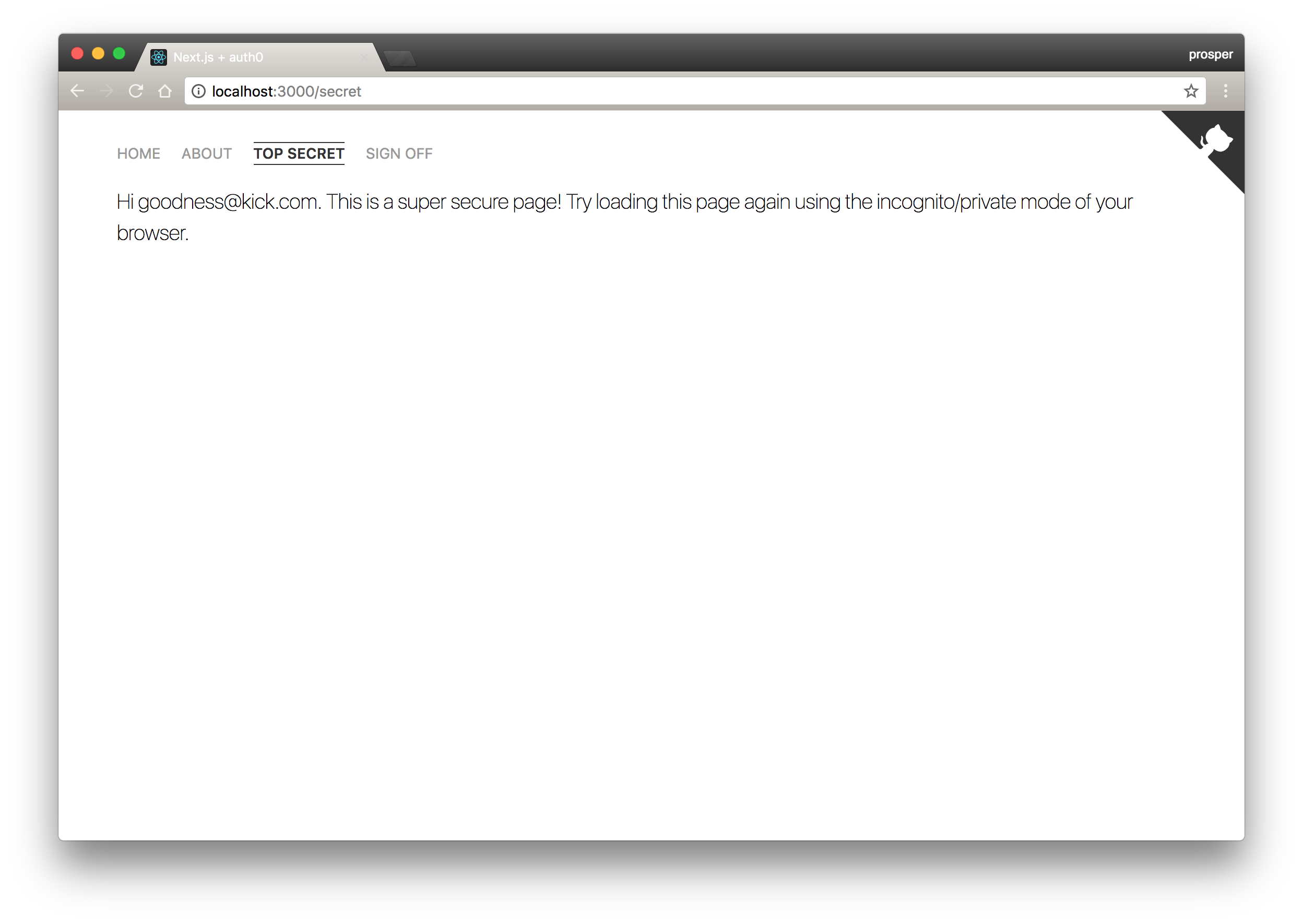
pages/index.js
import React, { PropTypes } from 'react'
import Link from 'next/link'
import defaultPage from '../hocs/defaultPage'
const SuperSecretDiv = () => (
<div>
This is a super secret div.
<style jsx>{`
div {
background-color: #ecf0f1;
box-shadow: 0 1px 3px rgba(0,0,0,0.12), 0 1px 2px rgba(0,0,0,0.24);
border-radius: 2px;
padding: 10px;
min-height: 100px;
display: flex;
align-items: center;
justify-content: center;
color: #333;
text-align: center;
font-size: 40px;
font-weight: 100;
margin-bottom: 30px;
}
`}</style>
</div>
)
const createLink = (href, text) => (
<a href={href}>
{text}
<style jsx>{`
a {
color: #333;
padding-bottom: 2px;
border-bottom: 1px solid #ccc;
text-decoration: none;
font-weight: 400;
line-height: 30px;
transition: border-bottom .2s;
}
a:hover {
border-bottom-color: #333;
}
`}</style>
</a>
)
const Index = ({ isAuthenticated }) => (
<div>
{isAuthenticated && <SuperSecretDiv />}
<div className='main'>
<h1>Hello, friend!</h1>
<p>
This is a super simple example of how to use {createLink('https://github.com/zeit/next.js', 'next.js')} and {createLink('https://auth0.com/', 'Auth0')} together.
</p>
{!isAuthenticated && (
<p>
You're not authenticated yet. Maybe you want to <Link href='/auth/sign-in'>{createLink('/auth/sign-in', 'sign in')}</Link> and see what happens?
</p>
)}
{isAuthenticated && (
<p>
Now that you're authenticated, maybe you should try going to our <Link href='/secret'>{createLink('/secret', 'super secret page')}</Link>!
</p>
)}
</div>
<style jsx>{`
.main {
max-width: 750px;
margin: 0 auto;
text-align: center;
}
h1 {
font-size: 40;
font-weight: 200;
line-height: 40px;
}
p {
font-size: 20px;
font-weight: 200;
line-height: 30px;
}
`}</style>
</div>
)
Index.propTypes = {
isAuthenticated: PropTypes.bool.isRequired
}
export default defaultPage(Index)The index page is server-rendered. It checks if the user is authenticated or not and renders content based on the status.
The secret page too checks if the user is logged in and determines content based on the user's status.
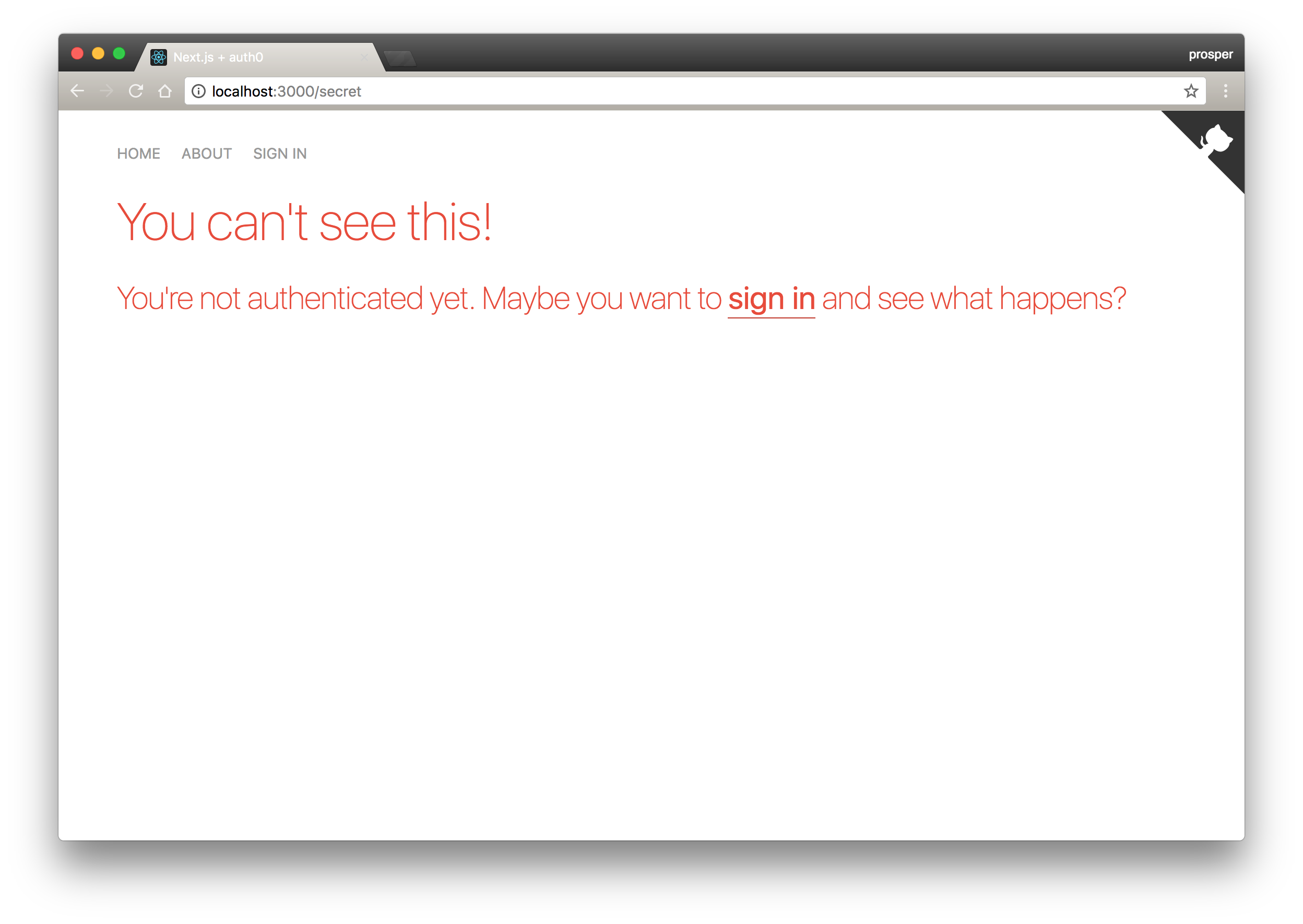
Note: Nextjs exposes virtually everything to the client. Secrets and environment variables are leaked to the frontend. So if you want to perform an API call and you need to validate a token based on a secret, then you will have to run a custom express server so that your secret can be available only on the server. This also applies to other forms of operations that require loading some secret environment variables that the user of your app shouldn't have access to.
Auth0 provides the simplest and easiest to use user interface tools to help administrators manage user identities including password resets, creating and provisioning, blocking and deleting users.
Conclusion
With Next.js 2, the Github repo now has over 11,000 stars and we have seen lots of significant improvements & major upgrades from the initial version that was released last year. Kudos to the team behind this lovely tool and the JavaScript community for their continuous support. In fact, they already have plans for Next.js 3.
Try out Next.js 2 and let me know what you think in the comments section!





